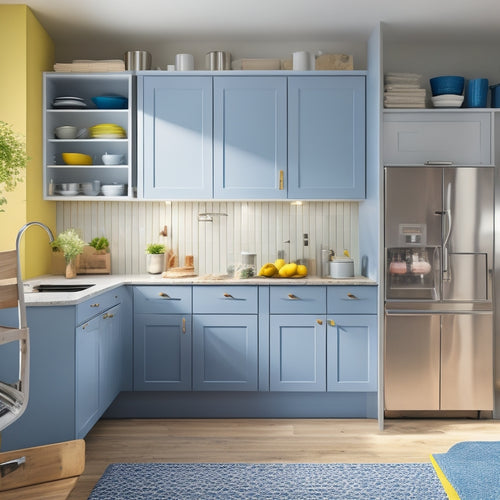
Organize Your Kitchen in 5 Easy Steps
Share
Get ready to transform your disordered kitchen into a sanctuary of efficiency and productivity! First, cleanse and declutter kitchen items by separating essentials from clutter and being honest about item usage. Next, assign a home for everything by categorizing similar items and designating specific storage areas. Maximize vertical storage space by utilizing hanging shelves and over-the-door racks. Utilize hidden storage areas like corners and cabinet backs. Finally, create a maintenance routine to guarantee your hard work doesn't go to waste. Now that you have a sense of where to start, let's dive deeper into each step to achieve a kitchen that truly works for you.
Key Takeaways
• Purge and declutter kitchen items by separating essentials from clutter, considering donation or disposal, and being honest about item usage.
• Assign a home for everything by categorizing similar items, grouping them together, and designating specific storage areas with a labeling system.
• Maximize vertical storage space by utilizing vertical areas, installing hanging shelves, and using over the door racks and wall-mounted baskets or hooks.
• Utilize hidden storage areas by installing carousels or lazy susans, using stackable bins or baskets, and attaching hooks or a pegboard on cabinet backs.
• Create a maintenance routine by establishing a regular cleaning plan, committing to daily cleaning tasks, and scheduling weekly organizing sessions.
Purge and Declutter Kitchen Items
Start by gathering three boxes or bins labeled 'keep,' 'donate/sell,' and 'toss' to sort through your kitchen items and separate the essentials from the clutter. This simple step will help you identify what you need, what you can get rid of, and what you can give to others.
As you sort, be honest with yourself - when was the last time you used that kitchen gadget? If it's been a while, consider adding it to the donation pile or tossing it altogether.
Assign a Home for Everything
Now that you've purged your kitchen of unnecessary items, it's time to assign a home for each remaining item, so everything has a designated place and can be easily found when needed. This step is pivotal in maintaining your newly organized kitchen.
Start by categorizing similar items, such as baking supplies or cooking utensils, and group them together. Then, decide where each group will live in your kitchen. For example, you might designate a specific drawer for baking supplies and another for cooking utensils.
To keep items organized within their assigned homes, consider implementing a labeling system. This can be as simple as using stickers or labels to identify what's inside a cabinet or on a shelf. You can also use drawer dividers to separate items within a drawer and keep them from getting jumbled.
Maximize Vertical Storage Space
You can access valuable storage space in your kitchen by utilizing the often-wasted vertical areas between countertops and ceiling. By doing so, you'll create more room for your kitchen essentials without sacrificing floor space.
One effective way to maximize vertical storage is by installing hanging shelves. These can be placed above countertops, near windows, or even above appliances to store infrequently used items like special occasion dishes or cookbooks.
Over the door racks are another great option, perfect for storing spices, oils, or snacks. You can also use wall-mounted baskets or hooks to hang utensils, aprons, or bags, keeping them organized and within easy reach.
When choosing vertical storage solutions, consider the items you need to store and the space available. Measure your walls and countertops to guarantee a perfect fit.
Utilize Hidden Storage Areas
Beyond maximizing vertical storage space, take advantage of hidden areas in your kitchen to stash items that are not frequently used, freeing up even more space for daily essentials. You can utilize underutilized corners by installing carousels or lazy susans, making it easy to access items stored in hard-to-reach areas.
| Hidden Storage Area | Optimization Ideas |
|---|---|
| Underutilized Corners | Install carousels or lazy susans |
| Shelves Above Cabinets | Use stackable bins or baskets |
| Cabinet Backs | Attach adhesive hooks or a pegboard |
| Drawer Bottoms | Add a slide-out drawer organizer |
Optimize cabinet space by using dividers or baskets to categorize and store items. You can also use the back of cabinet doors to hang frequently used items like spices, oils, or utensils. Additionally, consider using the space under your kitchen sink by installing a slide-out trash can or a storage bin. By utilizing these hidden areas, you'll be able to free up more space in your kitchen for the items you use daily.
Create a Maintenance Routine
Establish a regular cleaning plan to maintain your newly organized kitchen and secure it remains clutter-free and functional over time. To keep your kitchen organized, you'll need to commit to daily cleaning and weekly organizing tasks.
Set aside a few minutes each day to wipe down countertops, clean up after meals, and put away dishes. This daily cleaning routine will prevent clutter from building up and make weekly organizing tasks much easier.
Schedule a weekly organizing session to tackle deeper cleaning tasks, such as cleaning the oven, refrigerator, and sink. This will help maintain your kitchen's functionality and prevent clutter from accumulating.
Consider setting a reminder on your calendar to secure you stay on track with your scheduled maintenance. By incorporating daily cleaning and weekly organizing into your routine, you'll be able to prevent clutter from taking over your kitchen and keep it running smoothly.
Related Posts
-

Smart Storage Solutions for Small Kitchen Spaces
You're struggling to find space in your small kitchen, but don't worry, smart storage solutions can help. Start by ut...
-

Transform Your Bathroom to Boost Home Sales
When you transform your bathroom into a serene oasis, you're not just making it look pretty - you're tapping into buy...

